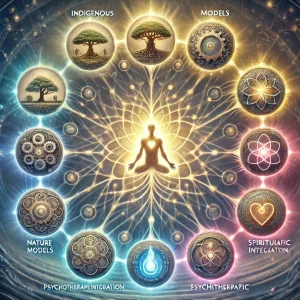 As the world continues to witness a resurgence in the therapeutic use of psychedelics, the conversation surrounding psychedelic integration is more important than ever. Integration, often defined as the process of incorporating insights and experiences from a psychedelic journey into daily life, can significantly impact the long-term benefits of such experiences. However, how this integration is approached varies widely. There are many models designed to guide individuals and therapists through the integration process, each offering its own framework for making sense of these profound experiences.
As the world continues to witness a resurgence in the therapeutic use of psychedelics, the conversation surrounding psychedelic integration is more important than ever. Integration, often defined as the process of incorporating insights and experiences from a psychedelic journey into daily life, can significantly impact the long-term benefits of such experiences. However, how this integration is approached varies widely. There are many models designed to guide individuals and therapists through the integration process, each offering its own framework for making sense of these profound experiences.
In this article, we will explore ten different models of psychedelic integration, showcasing the diversity of approaches that have been developed to help individuals make sense of and apply the lessons from their psychedelic journeys.
1. Visionary Plant Medicine Integration (Coder, 2017)
This model is deeply influenced by Indigenous shamanic practices and Transpersonal Psychology. It is designed for those who participate in plant-based ceremonies with substances like ayahuasca or iboga. This seven-domain model focuses on Reflection, Creative Expression, Meaning Making, and Physical Care, among other aspects. It offers a holistic approach, addressing both the spiritual and physical components of integration. By tapping into ancient wisdom, this model connects individuals with the roots of Indigenous practices, guiding them to integrate their personal revelations with a sense of grounding and balance.
2. Holistic Model for a Balanced Life (Bourzat and Hunter, 2019)
This model, also rooted in Indigenous wisdom, balances five interconnected domains: Body, Mind, Spirit, Community, and Nature. It encourages individuals to focus on these aspects equally, blending self-care with communal engagement and spiritual growth. This model is perfect for those seeking a well-rounded approach to integration that includes their relationships with the world around them. It underscores the need to reconnect with both oneself and nature as an integral part of the healing process.
3. Realms of Integration (Buller and Moore, 2019)
The Realms of Integration model offers a biopsychosocialspiritual framework, organizing the integration process into six realms: Relationships, Mental/Intellectual, Mind-Body, Environmental, Spiritual, and Lifestyle/Career. Although it identifies different areas for integration, it is less detailed in its step-by-step process, focusing more on providing a broad structure. For individuals who prefer a comprehensive, but flexible model, this framework allows them to explore multiple aspects of their life and how they intersect with their psychedelic insights.
4. Psychedelic Harm Reduction and Integration (Gorman et al., 2021)
This model combines mindfulness-based and psychodynamic approaches with harm reduction principles. It is especially useful for individuals who have experienced difficult or challenging psychedelic journeys. This model emphasizes psychological safety and growth, helping participants work through unresolved feelings or emotions from their experience. By offering tools to navigate both positive and difficult aspects, this model presents a balanced and compassionate approach to psychedelic integration.
5. Psychedelic-Inclusive Model of the Psyche (Ortigo, 2021)
Inspired by Jungian psychology, this model addresses the interaction between the conscious and unconscious mind. It helps individuals to navigate and integrate their experiences across thought, emotion, body, and behavior. For those interested in a depth-psychology approach, this model brings a spiritual and existential dimension to integration, inviting individuals to explore their psyche’s hidden parts through archetypes and symbols.
6. Ayahuasca Psycho-Spiritual Integration Model (Cohen, 2017)
The Ayahuasca Psycho-Spiritual Integration Model focuses specifically on ayahuasca ceremonies and how participants can integrate their experiences post-ceremony. With a five-phase process that includes pre-ceremony preparation, the ceremony itself, post-ceremony integration, and ongoing practices, this model provides a structured yet spiritually informed approach to integration. It draws from both Jungian concepts and spiritual traditions, offering a tailored model for those seeking to integrate ayahuasca experiences.
7. ACT for Psychedelic Integration (Sloshower et al., 2020)
Drawing from Acceptance and Commitment Therapy (ACT), this model focuses on six principles: present moment awareness, acceptance, cognitive diffusion, self as context, values, and committed action. It offers a behavioral approach to integration, helping individuals translate their psychedelic experiences into actionable, value-driven changes in their lives. The ACT model is ideal for those looking for a structured and practical framework to maintain the therapeutic benefits of psychedelic experiences, especially in clinical settings.
8. ACE Model (Watts and Luoma, 2020)
The ACE model—Accept, Connect, Embody—proposes three stages for integration. It encourages individuals to first accept their experiences, then connect them to a deeper meaning, and finally embody the changes they wish to see. This model is particularly useful for those who value meaning-making and are focused on creating actionable goals based on their insights. It integrates both psychotherapeutic and personal growth aspects, making it a well-rounded and goal-oriented approach.
9. SAFETY Framework (Westrum and Dufrechou, 2019)
The SAFETY framework, which stands for Security, Accessible, Fluidity, Empowering, Transformational, and Yours, is a spiritually grounded model that draws from Transpersonal Psychology. It emphasizes creating a safe, personal, and transformative space for integration. The framework encourages individuals to tailor the integration process to their own needs while fostering a deep sense of security and empowerment. This model is excellent for those seeking a personalized and flexible integration process.
10. Nature-Relatedness Model (Gandy et al., 2020)
This model emphasizes the connection between psychedelic experiences and the natural world, encouraging individuals to integrate their experiences through rituals and practices that enhance their bond with nature. It is particularly useful for those who experience heightened environmental awareness after their journeys and want to incorporate nature-based practices such as forest bathing, gardening, or spending time in wilderness settings. For individuals seeking to ground themselves through connection with nature, this model offers a rich, ecological approach to integration.
The Diversity of Integration: No One-Size-Fits-All Approach
What makes these ten models of psychedelic integration so diverse is the range of philosophical, therapeutic, and cultural influences that shape each one. From Indigenous wisdom and Jungian psychology to Acceptance and Commitment Therapy and nature-based approaches, these models offer individuals and therapists a variety of tools to choose from. Each model emphasizes different aspects of the human experience—whether it’s body, mind, spirit, community, or the natural world—allowing for a personalized and multidimensional approach to integration.
Some models prioritize a therapeutic structure with an emphasis on psychological safety, while others focus on spiritual and existential growth, encouraging participants to explore their connection to a larger cosmic order. For those seeking a holistic experience, models like the Visionary Plant Medicine or Holistic Model for a Balanced Life offer expansive frameworks that address multiple domains of life. Meanwhile, more structured, goal-oriented models like ACT and ACE provide clear steps for translating psychedelic insights into real-world actions.
Why This Matters Today
As the psychedelic renaissance continues to unfold, the need for diverse and adaptable integration models is growing. These models not only cater to individuals with different therapeutic needs and cultural backgrounds but also highlight the vast potential of psychedelics in fostering personal growth, healing, and transformation. No single model is the right answer for everyone, and the diversity of approaches ensures that each person can find a pathway that resonates with their unique journey.
Whether you are seeking a spiritually grounded process, a therapeutic framework, or a nature-centered approach, there is a model that can guide you in integrating the profound insights gained through psychedelic experiences. The diversity of these models reflects the rich complexity of the human experience itself—showing that there are many ways to heal, grow, and connect with ourselves and the world around us.




